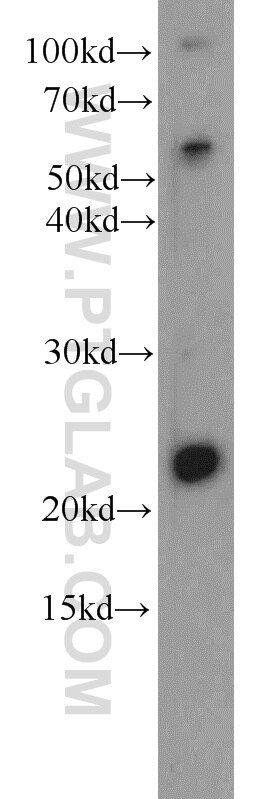Tested Applications
| Positive WB detected in | rat skin tissue |
Recommended dilution
| Application | Dilution |
|---|---|
| Western Blot (WB) | WB : 1:500-1:2000 |
| It is recommended that this reagent should be titrated in each testing system to obtain optimal results. | |
| Sample-dependent, Check data in validation data gallery. | |
Product Information
14777-1-AP targets Dermatopontin in WB, ELISA applications and shows reactivity with human, rat samples.
| Tested Reactivity | human, rat |
| Host / Isotype | Rabbit / IgG |
| Class | Polyclonal |
| Type | Antibody |
| Immunogen |
CatNo: Ag6200 Product name: Recombinant human DPT protein Source: e coli.-derived, PET28a Tag: 6*His Domain: 1-201 aa of BC033736 Sequence: MDLSLLWVLLPLVTMAWGQYGDYGYPYQQYHDYSDDGWVNLNRQGFSYQCPQGQVIVAVRSIFSKKEGSDRQWNYACMPTPQSLGEPTECWWEEINRAGMEWYQTCSNNGLVAGFQSRYFESVLDREWQFYCCRYSKRCPYSCWLTIEYPGHYGEEMDMISYNYDYYIRGATTTFSAVERDRQWKFIMCRMTEYDCEFANV Predict reactive species |
| Full Name | dermatopontin |
| Calculated Molecular Weight | 22 kDa |
| Observed Molecular Weight | 22 kDa |
| GenBank Accession Number | BC033736 |
| Gene Symbol | DPT/TRAMP |
| Gene ID (NCBI) | 1805 |
| RRID | AB_2878078 |
| Conjugate | Unconjugated |
| Form | Liquid |
| Purification Method | Antigen affinity purification |
| UNIPROT ID | Q07507 |
| Storage Buffer | PBS with 0.02% sodium azide and 50% glycerol, pH 7.3. |
| Storage Conditions | Store at -20°C. Stable for one year after shipment. Aliquoting is unnecessary for -20oC storage. 20ul sizes contain 0.1% BSA. |
Background Information
DPT (dermatopontin) is an extracellular matrix protein belonging to the dermatopontin family. Skin appears to be the richest source of dermatopontin, comprising about 15 mg/kg of the wet weight. Expression of dermatopontin is not limited to connective tissue, as investigations show that dermatopontin mRNA is expressed in cultured fibroblasts, muscle, heart, pancreas, and lung. Dermatopontin comprises a considerable proportion of the noncollagenous extracellular matrix proteins. It is involved in promotion of cellular adhesion, extracellular matrix assembly and wound healing.
Protocols
| Product Specific Protocols | |
|---|---|
| WB protocol for Dermatopontin antibody 14777-1-AP | Download protocol |
| Standard Protocols | |
|---|---|
| Click here to view our Standard Protocols |






